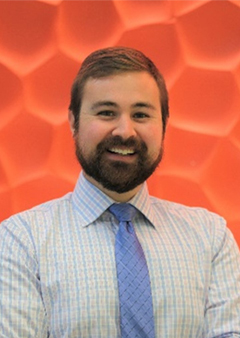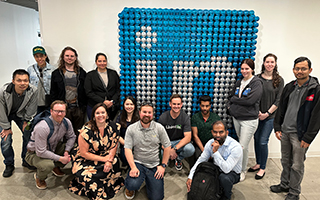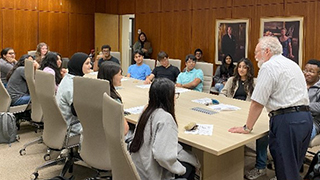November 29, 2023

Michael Petriello, Ph.D., works to uncover the mechanisms of how environmental pollutants affect nutrition and health. (Photo courtesy of Michael Petriello)
NIEHS grant recipient Michael Petriello, Ph.D., studies how the interplay between environmental pollutants and nutrition influences health. An assistant professor of environmental health sciences and of pharmacology at Wayne State University in Detroit, Petriello focuses on metabolic disorders such as diabetes, obesity, and cardiovascular disease in at-risk populations.
“I was always interested in human physiology as well as environmental science, but it wasn’t until I took a toxicology course as a senior that I figured out how I could combine both of these interests,” Petriello said.
After graduating from Muhlenberg College with degrees in biology and environmental science, Petriello pursued doctoral research at the University of Kentucky (UK) Superfund Research Program (SRP) Center. Working closely with former UK SRP director Bernhard Hennig, Ph.D., he dove into research on environmental pollutants, nutrition, and the importance of diet in health.
“At UK SRP, we focused on how to improve health and well-being through diet,” Petriello said. “We studied how ‘positive nutrition’ — incorporating dietary nutrients like omega-3 fatty acids and plant molecules called polyphenols — can bolster your own defenses against environmental pollutants.”
Finding Ties Between Nutrition and Toxicity
After earning a Ph.D. in toxicology, Petriello completed post-doctoral work in analytical chemistry and cardiovascular medicine, also at UK. Through support from UK SRP and an NIEHS Pathway to Independence Award, he gained additional expertise as a visiting scientist at Boston Children’s Hospital, part of Harvard Medical School. There, studied the metabolite trimethylamine N-oxide (TMAO), a biomarker, or indicator, of cardiovascular disease. When blood levels are high, TMAO can be a useful predictor of heart attacks and strokes.
TMAO forms when the body breaks down certain animal-derived foods like red meat and eggs. Petriello was curious whether TMAO levels fluctuated with exposure to chemicals resembling the banned substance dioxin. Dioxin-like substances have been linked to increased risk of cardiovascular disease.
“Studying TMAO marked my first foray into looking at how nutrition could actually exacerbate toxicity,” Petriello said.
Working with mice and human blood samples, he showed that increased exposure to dioxin-like pollutants was associated with higher TMAO levels. “There are multiple opportunities for environmental contaminants to impact TMAO levels,” Petriello explained. “In addition to diet, the formation of TMAO is dependent on your personal gut microbiome as well as detoxifying enzymes in your liver.”
Uncovering Links Between PFAS and Cholesterol
When Petriello joined Wayne State University as an assistant professor in 2019, he began studying PFAS, a large group of human-made chemicals found at high concentrations in drinking and surface water across Michigan.
“The first animal study that we worked on focused on a mixture of PFAS and its effects on lipid metabolism. PFAS exposure has been associated with increased cholesterol, which is the most important risk factor for coronary artery disease and atherosclerosis,” Petriello explained. “We wanted to focus on mixtures because PFAS are made up of thousands of different compounds, but traditionally, toxicologists usually only study one at a time.”
As co-director of the Wayne State SRP Center’s Research Experience and Training Coordination Core, Petriello helped organize a workshop with LinkedIn for trainees from a variety of disciplines. Trainees learned how to define their professional brand, build and optimize their LinkedIn profile, and expand their networks. (Photo courtesy of Michael Petriello)

As co-director of the Wayne State SRP Center’s Research Experience and Training Coordination Core, Petriello helped organize a workshop with LinkedIn for trainees from a variety of disciplines. Trainees learned how to define their professional brand, build and optimize their LinkedIn profile, and expand their networks. (Photo courtesy of Michael Petriello)
Petriello and colleagues exposed mice to water containing a mixture of five types of PFAS, including older and newer compounds. After 12 weeks, they found that PFAS exposure was associated with increased circulating cholesterol and bile acids.
“We really think the link between PFAS and cholesterol is through the bile acid pathway,” he explained. “If we can show that PFAS are harming this pathway, we can propose more targeted strategies to decrease the cardiovascular toxicity related to PFAS exposure.”
With new NIEHS funding, Petriello and his team will conduct a follow-up study using more advanced mixture methods and mice bred to exhibit human-like cholesterol profiles.
“We are going to look at associations between PFAS and cholesterol, and see if bile acid levels mediate these associations,” Petriello said.
Entering New Terrain
Through his work at Wayne State, Petriello has also become involved in the NIH-funded Environmental Influences on Child Health Outcomes (ECHO) Program. Established in 2016, ECHO supports studies using existing cohorts to investigate the effects of environmental exposures on maternal and child health and development. Through ECHO, Petriello received an Opportunities and Infrastructure Fund award for early investigators to focus on PFAS and the maternal gut microbiome.
“Working with ECHO has allowed me to continue to grow and step out of my comfort zone,” noted Petriello, who gained maternal health research experience through the program.
“I’ve met so many passionate and brilliant scientists who will turn out to be future collaborators. The ECHO program is a once-in-a-generation opportunity for scientists, especially young scientists, to investigate the role of environmental exposures on human health, focusing on some of the most susceptible time periods of life.”
Coming Full Circle

Petriello was introduced to high school students by Gil Mor, director of the C.S. Mott Center for Human Growth and Development at Wayne State University, to discuss career opportunities in toxicology. (Photo courtesy of Michael Petriello)
As a postdoc at the UK SRP Center, Petriello received training from the Research Experience and Training Coordination Core. Now, he co-directs the training core at Wayne State University’s new SRP Center, the Center for Leadership in Environmental Awareness and Research, where he hopes to apply lessons he learned at UK.
“During UK’s trainee-led meetings, we built some interesting, cross-cutting interdisciplinary collaborations just from sitting together and chatting over pizza,” Petriello recalled.
A dedicated mentor, Petriello supports trainees in writing grant proposals and developing new projects.
“I’ve focused on building collaborations and helping the next generation,” he said. “And I am very proud of bringing people into the realm of toxicology who may not have otherwise considered it.”


